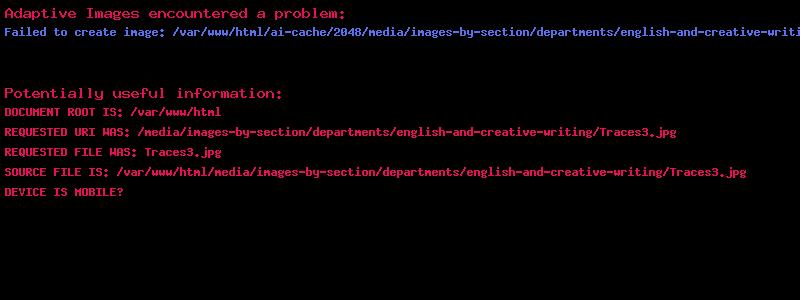GLITS 2013: 'Traces'
Article

'Oh you lost God! You endless trace!
Only because in the end hate divided you
are we now nature’s mouth and listeners.'
– Rilke, The Sonnets to Orpheus, First Series, 26; trans. C Bamford
Keynote Speaker: Professor Mark Currie
In the summer of 2013 Goldsmiths was proud to present Traces, the fifth annual Goldsmiths Literature Seminar Series (GLITS) interdisciplinary research conference organized by postgraduate students in the English and Comparative Literature Department. Organised around the broad theme of ‘the trace’, this conference built on the success and momentum of previous years and, attracting a great attendance, proved another stimulating, friendly and energetic event, and a forum for a wonderful array of research interests. The conference welcomed delegates representing universities from across the United Kingdom, as well as Canada and Hong Kong, to investigate the ethereal, the indefinite and even the grammatical aspects of the trace. The conference sought to open scholarly engagement with the trace not merely as an absence but as a presence, an erasure, a suspension of signs, that which ‘replaces a presence which has never been present, an origin by means of which nothing has begun’ (Derrida, 1967).
Professor Mark Currie from Queen Mary, University of London opened proceedings with a keynote address entitled ‘A Trace of the Future’. He gave an overview of the history of the trace in the discourses of the humanities, ranging from Plato through Augustine, Freud and Lacan, to poststructuralists and theorists of the postmodern such as Kristeva and Lyotard. Focusing on Derrida and his legacy for contemporary writers and philosophers such as Martin Hägglund, Mark Currie's address unravelled the ways in which various writers with vastly different agendas have been drawn to the futurity of the trace – the paradoxical power of the trace to confer necessity on something that is contingent. Whilst many of the papers given in this conference focused on visual traces, Mark Currie’s keynote focused on the abstraction of the trace as holding a clue to its potential. Whether conceived as a means of inscribing and thereby saving time as the spatial, or as a Derridean suture that at once holds together and separates, the trace has clearly intrigued because of its ability and tendency to bring together repetition and novelty. Repetition and event, discovery and invention: these are the terms which the trace so impossibly binds together. Derrida’s ‘Typewriter Ribbon’, his task of thinking together the machine (the repetition) and the event (the what happens), and the wonderful, novelistic grammatical construction of the future anterior – the ‘will have been’ – formed the key terms of the latter half of Professor Mark Currie’s address, which considered the question of how we are to write in the knowledge that we are inscribing not only an archive for the future, but an archive of the future. ‘What will have been this legacy?’, Derrida asks, and writing in spite of this question, in the awareness of it, is part of the ‘task and the legacy of deconstruction’. As Mark Currie concludes the opening chapter of his new book, The Invention of Deconstruction (London: Palgrave Macmillan, 2013),
In the future anterior, the thing that arrives from the future is also something that is complete and finished, like retrospect that is still to come, and this temporal loop will figure throughout the interpretation and the history that lies ahead.
Mark Currie’s discussion of deconstruction was, of course, a highly apt subject with which to commence a day of postgraduate research papers, with their myriad versions and revisions all under the looming auspice of a whole argument - the complete thesis. The papers given during the day explored the pursuit of meaning as a form of tracing – the academic process as one of seeking and deconstructing the patterns, motifs and voices of a specific field or ideology; excavating that which is lost, thus identifying the hole left by its absence. The conception of the trace was extended to multiple discursive frameworks and platforms, and a principle of hybridity resulted in some intriguing pairings. Sally Mann’s haunting photos of the Deep South resonated with the concept of the martyred author in Finnegans Wake; David Copperfield and Leopold Bloom seemed to involve themselves in an unlikely dialogue spurred on by the apocalypse of Jim Crace’s The Pesthouse. The narratives of histories and cultures as well as art and literature were examined for the trace they bear, the revelation that they await. The ‘presence’ of absent objects was used to question how we use corporeal traces to contextualise lost histories, and such objects were shown to bear the trace of the intersection of cultural transformation, creative materiality and economic development. Panels were arranged around the temporal, the material, the spectral and, of course, the intertextual. The full programme with abstracts and contact details can be seen here GLITS%202013%20programmeand further information is available on the Traces website: http://glitstraces2013.wordpress.com/.
Traces once again enabled a dynamic diaspora of postgraduate researchers to share ideas and approaches within the welcoming walls of Goldsmiths. The organisers would like to thank Professor Mark Currie for his wonderful keynote address, and the English and Comparative Literature Department and the Graduate School at Goldsmiths for support and funding. We want to thank Michael Simpson, Jacqueline Rattray and Lesley Hewings for their help in making the conference possible. We would like to give particular thanks to Richard Bolley and to Maria Macdonald in the English and Comparative Literature Department for their invaluable advice and assistance in making the organisation a joy and the day a great success.
Johanna O'Shea and Emma Grundy Haigh
Traces Organisers: Alice Condé, Johanna O'Shea, Emma Grundy Haigh, Monika Loewy and Jasmine Richards (English and Comparative Literature Department, Goldsmiths, University of London)